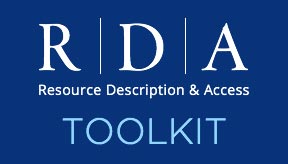Kate James presents "Use Cases for Official RDA"

The following article was written in April 2022 by Kate James, instructor for the 2022 RDA Lab Series - which commences virtually this month. Learn more about the series here.
Use Cases for Official RDA
by Kate James
Currently, I am cataloging special collections resources. Some of these are published and some are unpublished (aka “produced”). Some of the resources are cataloged individually and some done as collections, depending on decisions previously made by the library for which I’m cataloging. I’ve encountered monographic volumes, single issues of serials, single sheets of text, charts, maps, illustrations removed from publications, and articles detached from serials. Although the new RDA became official two years ago, I am using original RDA because I am cataloging in a shared environment using a MARC format interface that has not been updated to reflect official RDA. I understand this is necessary while large cataloging agencies decide when to implement official RDA. Sometimes though, I find myself wishing I could use official RDA, because a better cataloging solution is available in it.
These are my observations about how I think official RDA is better suited for some of my recent cataloging situations. I hope you will read this and feel a bit more curious about exploring the new RDA Toolkit. I realize the cataloging scenarios I am describing may be completely unfamiliar to you. These are the challenges and joys of special collections cataloging. Situations like this happen multiple times a week in my current cataloging work. When I catalog commercially published monographs, I have found they are described well with either original or official RDA, and I would use the same elements for the resource description.
The lack of core elements may better serve resource description.
The core elements in original RDA reflect the FRBR attributes and relationships determined to have a high value for meeting user tasks. However, the importance of a specific element in meeting a user task will vary depending on the specific resource and cataloging approach. For instance, I had a collection of several pamphlets describing products from different manufacturers. In original RDA, place of publication, publisher’s name, and date of publication are core elements for published manifestations, which these are. Transcribing these elements for each pamphlet is not practical. Transcribing one set of publication elements from one pamphlet to fulfill the core requirement does not seem to help the user identify the collection, and perhaps gives the user a false impression. Although though many institutions do “collection level cataloging” for published pamphlets, broadsides, etc., about a specific subject, original RDA Chapter 2 sometimes did not accommodate this. Because official RDA does not have core elements, my description is “RDA cataloging” without transcribing publication elements for the pamphlet collection. (There are probably many bibliographic records coded “rda” for collections of published manifestations that do not conform to RDA 2.8, and I hope no one reading this will worry about any practical decisions made for collection-level cataloging.)
Flexibility in sources of information enables easier description.
Original RDA has a prescribed order of sources of information for many elements, e.g., for date of publication, the order is a) the same source as a title proper, b) another source within the manifestation itself, and c) one of the other sources of information specified at 2.2.4. Great thought was given to these sources of information--they reflect sources that are prominent and cannot easily be separated from the manifestation. This order of sources also provides for a certain level of consistency in description, making it easier for institutions to share records and to verify if they have the same manifestation.
However, sometimes the manifestation’s sources of information do not present the data in a useful way. For example, I had a published manifestation with what I think was a date of publication on the same source as the title proper, but I was only able to determine that there was a month ending in “-ember” and the second digit of the year was “9.” The ink on the manifestation had deteriorated badly so I doubt anyone would have been able to read this. This was not a commercial publication—it was made for the institution’s students, so it is unlikely there are many copies around today. The lack of any existing records in a shared cataloging interface supports this. I had a probable range of dates when it was published based on text I could read, but that would be a cataloger-supplied date of publication. Regardless of what original RDA instructions said about sources of information, the only practical choice I could make was to supply a date of publication, e.g., “[between 1960 and 1965].” With official RDA, I would have just supplied the date and saved myself the time (and eyestrain) of trying to read the faded print in a futile attempt to satisfy instructions about a preferred order of sources of information.
Manifestation statement elements are for all manifestations.
In a previous job, I cataloged a lot of pre-1801 publications written in Latin so I knew how useful manifestation statement elements in official RDA would be for those books. However, I have been surprised to realize how often they would be useful with my current cataloging of more modern manifestations, most of which are written in English.
I recently cataloged a manifestation in which I am not completely sure where the title proper ended and the statement of responsibility began because it was mostly acronyms. Normally, I would have been able to figure this out from other information in the manifestation, but this manifestation was just a few pages and was probably meant to be an insert for another publication. The string of characters I transcribed would not have been any different with official RDA than with original RDA, but I would have transcribed them in a different element. I would have used manifestation title and responsibility statement rather than the two elements title proper and statement of responsibility relating to title proper. That would have saved me the time of agonizing about which element the data belong to, as I had to do with original RDA. This goes back to my first point as both title proper and statement of responsibility relating to title proper are core elements in original RDA. With official RDA, I would have used my cataloger judgment to determine that manifestation title and responsibility statement was the more efficient element for my manifestation description.
Cataloging communities will make their own decisions about when to start using official RDA. In the meantime, I hope that my observations as a practicing cataloger will encourage you to take a deeper look at official RDA and see some of the benefits to your future cataloging.
